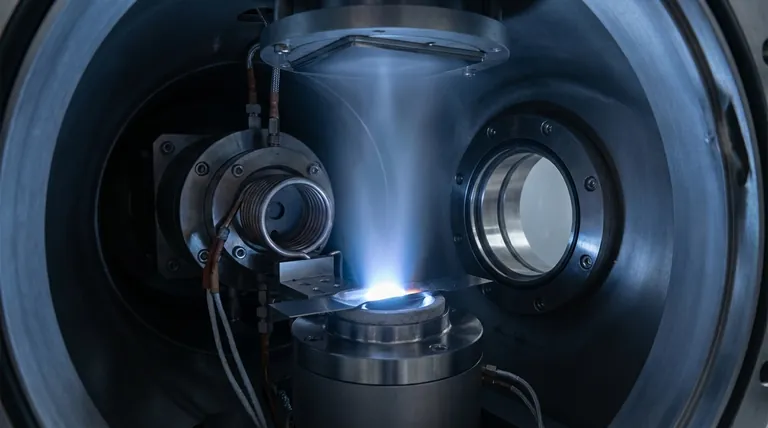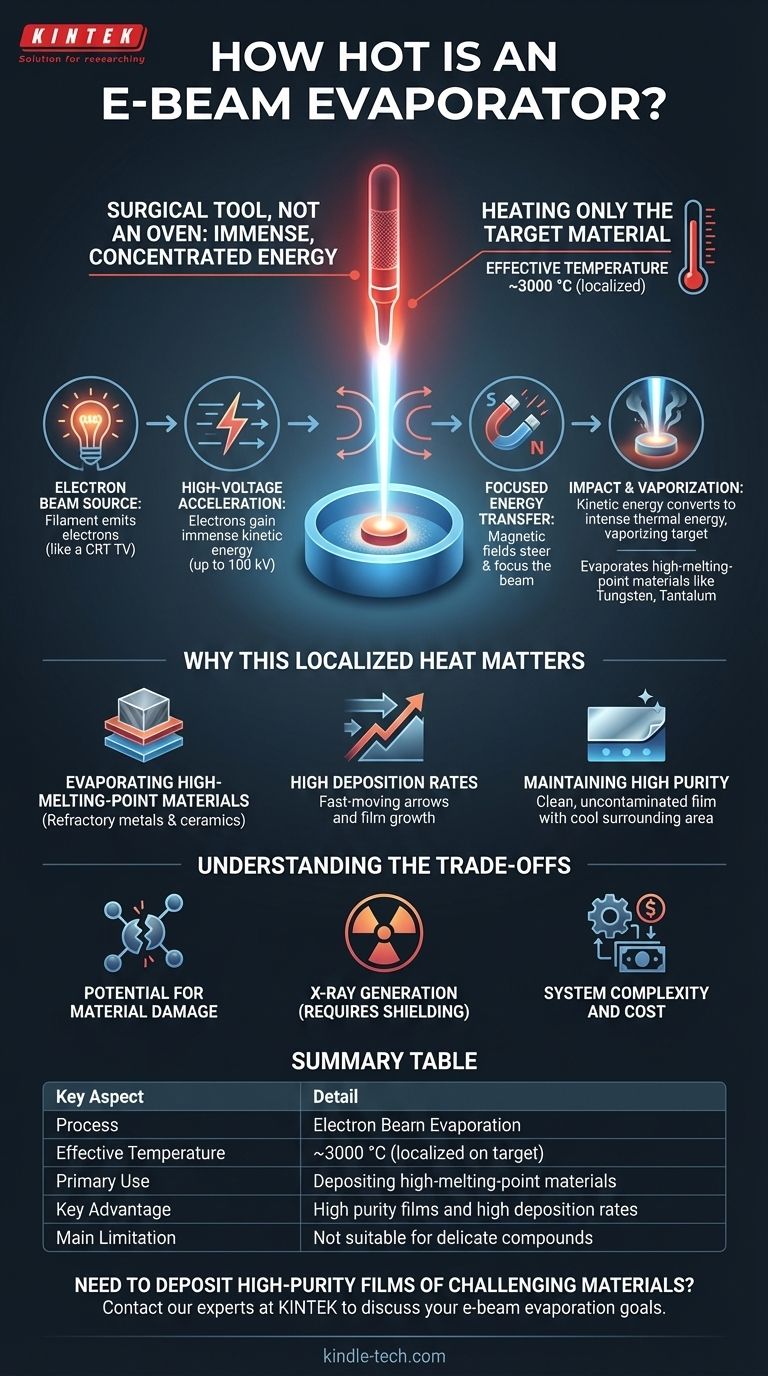While there is no single "temperature" for the evaporator itself, the process generates an intensely focused point of heat on the target material, often reaching an effective temperature around 3000 °C. This is not the temperature of the entire vacuum chamber, but rather the localized result of a high-energy electron beam converting its kinetic energy into thermal energy upon impact. This method allows for the evaporation of materials with extremely high melting points.
The key to understanding an e-beam evaporator's temperature is to stop thinking of it as an oven. Instead, view it as a surgical tool that delivers immense, concentrated energy to a tiny spot, heating only the target material to its vaporization point while the surrounding environment remains relatively cool.

How E-Beam Evaporation Generates Extreme Heat
The high temperatures in e-beam evaporation are not achieved through conventional heating. They are the direct result of a physical process involving the transfer of kinetic energy.
The Electron Beam Source
The process begins with a filament, typically made of tungsten, which is heated to emit a cloud of electrons. This is similar to the principle of an old cathode-ray tube television.
High-Voltage Acceleration
These free electrons are then accelerated by a powerful electric field, created by a high-voltage source that can be on the order of 100 kilovolts (kV). This acceleration gives the electrons immense kinetic energy.
Focused Energy Transfer
Magnetic fields are used to precisely steer and focus these high-energy electrons into a tight beam, directing it onto the source material (often called a "puck" or "charge") held in a crucible.
The 3000 °C Figure Explained
When this focused beam of high-velocity electrons strikes the material, their kinetic energy is instantly converted into intense thermal energy at the point of impact. This localized heating is so powerful that it can melt and then vaporize even refractory metals like tungsten or tantalum, which have melting points well above 3000 °C.
Why This Localized Heat Matters
This method of targeted heating provides several distinct advantages over other deposition techniques that heat the entire source material.
Evaporating High-Melting-Point Materials
The primary benefit is the ability to deposit films of materials that are impossible to evaporate with simpler thermal methods. This includes ceramics and refractory metals crucial for semiconductor and optical applications.
High Deposition Rates
Because the energy transfer is so efficient and intense, the source material evaporates very quickly. This allows for significantly higher deposition rates compared to techniques like sputtering or standard thermal evaporation.
Maintaining High Purity
Since only a small spot on the source material is superheated, the surrounding crucible and the chamber walls remain cool. This drastically reduces the risk of contamination, leading to purer deposited films.
Understanding the Trade-offs
While powerful, the e-beam process is not universally applicable and comes with its own set of challenges.
Potential for Material Damage
The intense, direct energy beam can be too destructive for certain materials. It can decompose complex chemical compounds or damage delicate organic materials, making it unsuitable for those applications.
X-Ray Generation
A critical safety consideration is that the impact of high-energy electrons on a target material inevitably produces X-rays. The vacuum chamber must be properly shielded to protect operators from radiation exposure.
System Complexity and Cost
E-beam evaporators require sophisticated high-voltage power supplies, magnetic beam-steering systems, and high-vacuum chambers. This makes the equipment significantly more complex and expensive than simpler deposition systems.
Making the Right Choice for Your Goal
The extreme, localized heating of e-beam evaporation makes it a specialized tool. Your material and desired film properties will determine if it's the correct choice.
- If your primary focus is depositing refractory metals or ceramics: E-beam evaporation is the industry standard and often the only viable choice.
- If your primary focus is achieving the highest possible film purity: E-beam is an excellent option due to the minimal heating of surrounding components.
- If your primary focus is depositing complex compounds or polymers: You should consider less destructive methods like thermal evaporation or sputtering.
Ultimately, e-beam evaporation's power lies in its precise and overwhelming delivery of energy exactly where it is needed.
Summary Table:
| Key Aspect | Detail |
|---|---|
| Process | Electron Beam Evaporation |
| Effective Temperature | ~3000 °C (localized on target) |
| Primary Use | Depositing high-melting-point materials (e.g., Tungsten, Tantalum) |
| Key Advantage | High purity films and high deposition rates |
| Main Limitation | Not suitable for delicate compounds due to potential damage |
Need to deposit high-purity films of challenging materials?
At KINTEK, we specialize in advanced lab equipment, including e-beam evaporation systems designed for precision and reliability. Our solutions help laboratories working with refractory metals, ceramics, and other high-performance materials achieve superior results with high deposition rates and exceptional purity.
Contact our experts today to discuss how our e-beam evaporators can meet your specific research or production goals.
Visual Guide

Related Products
- Molybdenum Tungsten Tantalum Evaporation Boat for High Temperature Applications
- Electron Beam Evaporation Coating Conductive Boron Nitride Crucible BN Crucible
- E Beam Crucibles Electron Gun Beam Crucible for Evaporation
- RF PECVD System Radio Frequency Plasma-Enhanced Chemical Vapor Deposition RF PECVD
- Split Chamber CVD Tube Furnace with Vacuum Station Chemical Vapor Deposition System Equipment Machine
People Also Ask
- What is vacuum thermal evaporation? A Guide to High-Purity Thin Film Deposition
- What are the drawbacks of thermal evaporation? Understanding the Limitations for High-Performance Applications
- What is thermal effect via evaporation? A Simple Guide to Thin-Film Deposition
- What is the widely used boat made of in thermal evaporation? Choosing the Right Material for High-Purity Deposition
- What is the difference between sputtering and thermal evaporation? Choose the Right PVD Method for Your Thin Film



















